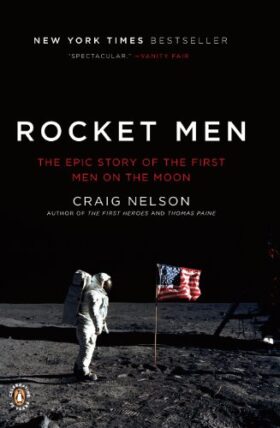
Rocket Men
Author: Craig Nelson
Release: June 25, 2009
Tagline: The Epic Story of the First Men on the Moon
Publisher: Viking Adult
Genre: History, Aerospace, Aeronautics, Politics, Technology
ISBN-10: 0670021032
ISBN-13: 978-0670021031
Declassified by Agent Palmer: Rocket Men Defines Apollo 11 Mission Better Than Anything Else I’ve Read
Quotes and Lines
The Saturn V rocket’s bottom stage was built by Boeing at the Michoud Assembly Factory in New Orleans, barged down the Mississippi River, around the Florida peninsula, and through a series of canals to the VAB–the great, shimmering reflecting pool that has graced so many NASA launch photos is in fact a turning basin for its arriving barges.
This group was then subjected to physical and psychological testing (from such endurance tests as treadmill running and balloon blowing to “Write twenty answers to the question, Who am I?”
It is unlikely that any of the hundreds of thousands of men and women working valiantly to make Apollo 11 succeed that day had even one moment of peace to consider the question at the heart of this massive undertaking: Why was the American federal government spending $29.5 billion to send human beings to the Moon? The headlong race to be first to another planet had been going on for so long and with such vigor that the only ones addressing this question were a group of social critics who believed that NASA’s money could be better spent on earthly matters. But the history of everything that led up to Apollo 11 in fact is as complex and extraordinary as the story of Apollo 11 itself, a saga of remarkable coincidence, fortuitous happenstance, and everyday heroism, motivated by a complex range of fac- tors: Fear. Discovery. Honor. Prestige. Charisma. Politics. Public relations. The 1960s. Humiliation. Because great nations do great things. Because it is there.
“We are facing an implacable enemy whose avowed objective is world domination,” announced the 1954 Doolittle Report, a classified overview of American covert operations. “There are no rules in such a game. Hitherto acceptable norms of human conduct do not apply.” Americans must “learn to be able not to be good,” and the American public “must be made acquainted with, understand and support this fundamentally repugnant philosophy.”
The only problem with eyes in the sky was that the vast majority of their pictures were of clouds. The Pentagon wanted to correct this by canceling Dyna-Soar and launching instead a Manned Orbiting Laboratory–MOL–using Gemini equipment to house two officers for thirty days of spying in orbit with a camera the size of a Chevy.
…rockets have a way to them; there’s something moody about explosives.
We now stand at what is undoubtedly the greatest decision point in the history of this planet. Four billion years ago the earth was formed. Four hun- dred million years ago life moved to the land. Four million years ago man appeared on earth. One hundred years ago the technological revolution that led to this day began. All of these events were important, yet in none of them did man make a conscious decision that would change the future of all mankind. We have that opportunity and that challenge today.
There remains for mankind the task of deciding the next step. Will we press forward to explore the other planets or will we deny the opportunity of the future? To me the choice is clear. We must take the next step. Should we hesitate to exploit the first step? Should we withdraw in fear from the next step? Or should we substitute temporary material welfare for spiritual adven- ture and long-term accomplishment? Then will man fall back from his des- tiny. The mighty surge of his achievement will be lost and the confines of this planet will destroy it.
This is the time for a decision. This is the time for rededication to the spirit of our forefathers. A time for all men to move forward and together. The organization that brought men to the moon stands ready for the next step. The knowledge possessed by men is sufficient, the resources are adequate for the task of carrying out this next step. The will of the people of this nation and of the world will determine whether mankind will make the great leap to the planets.
In this moment of man’s greatest achievement it is timely to dedicate our- selves to the unfinished work so nobly begotten by three of us. To resolve that this nation, under God, will join with all men in the pursuit of the destiny of mankind will lead to the way of the planets.
The PR motivation for NASA’s birth had been achieved beyond anyone’s wildest dreams. Apollo 11 marked the global apogee of American power, prestige, and influence.
And he got up at a blackboard and he drew four curves. They looked kind of like mountain peaks. And he had them out all like this. And he had one of them titled “Leadership.” He had one titled “Threat.” He had one of them titled “Good Economy.” And he had one of them, I think was the last one, was “Peace” or “World Peace,” something like that. He said, “My theory is that when you get all of those curves in conjunction, when they all line up together, you can do something like Apollo. Apollo, or something like it, will happen. And we happened to be ready for that when all of those curves lined up.” And, he kind of stole the show of this whole three-day get-together. And he was right on.